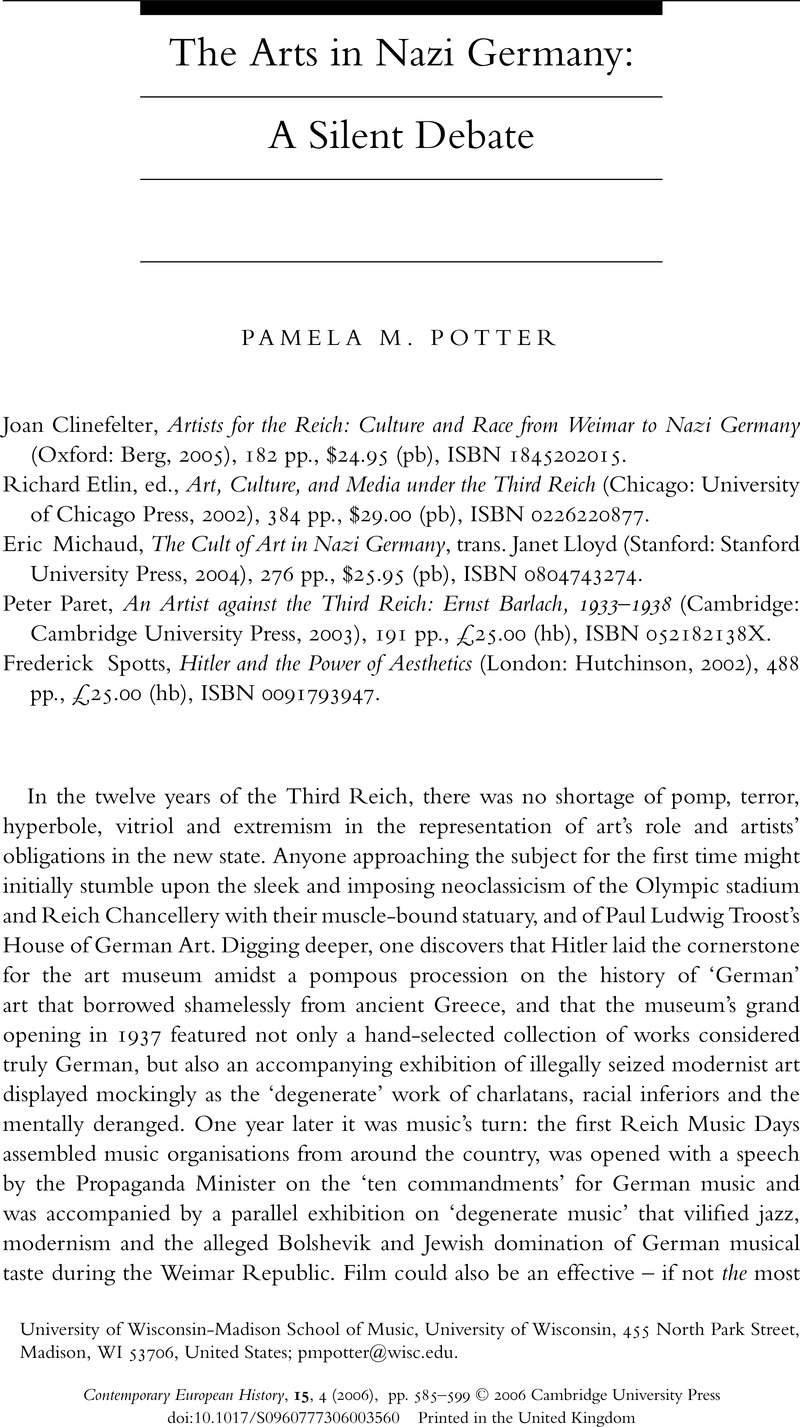Published online by Cambridge University Press: 06 October 2006

1 Quoted in Monod, David, Settling Scores: German Music, Denazification, and the Americans, 1945–1953 (Chapel Hill: University of North Carolina Press, 2005), 116Google Scholar.
2 Brenner, Hildegard, Die Kunstpolitik des Nationalsozialismus (Hamburg: Rowohlt, 1963)Google Scholar; and ‘Art in the Political Power Struggle of 1933 and 1934’, in Holborn, Hajo, ed., Republic to Reich: The Making of the Nazi Revolution (New York: Pantheon, 1972), 394–432Google Scholar.
3 Lane, Barbara Miller, Architecture and Politics in Germany, 1918–1945 (Cambridge, MA: Harvard University Press, 1968, 1985)Google Scholar.
4 The series ‘Kunst und Kultur im Dritten Reich’(Gütersloh: Sigbert Mohn Verlag) consisted of the following volumes, all edited by Wulf: vol. 1: Die bildenden Künste im Dritten Reich; vol. 2: Musik im Dritten Reich (1963); vol. 3: Literatur und Dichtung im Dritten Reich (1963); vol. 4: Theater und Film im Dritten Reich (1964); and vol. 5: Presse und Funk im Dritten Reich (1964).
5 Steinweis, Alan E., Art, Ideology, and Economics in Nazi Germany: The Reich Chambers of Music, Theater, and the Visual Arts (Chapel Hill: University of North Carolina Press, 1993)Google Scholar.
6 Petropoulos, Jonathan, Art as Politics in the Third Reich (Chapel Hill: University of North Carolina Press, 1996)Google Scholar.
7 Kater, Michael H., Different Drummers: Jazz in the Culture of Nazi Germany (Oxford: Oxford University Press, 1992)Google Scholar; The Twisted Muse: Musicians and Their Music in the Third Reich (New York: Oxford University Press, 1997); and Composers of the Nazi Era: Eight Portraits (New York: Oxford University Press, 2000).
8 Cuomo, Glenn, ed., National Socialist Cultural Policy (New York: St. Martin's Press, 1995)Google Scholar.
9 Peter Jelavich, ‘Review Article: National Socialism, Art and Power in the 1930s’, Past and Present, 164 (August 1999), 244–65; Marchand, Suzanne, ‘Nazi Culture: Banality or Barbarism?’ The Journal of Modern History, 70, 1 (1998), 108–18CrossRefGoogle Scholar.
10 See, for example, Peters, Olaf, Neue Sachlichkeit und Nationalsozialismus: Affirmation und Kritik 1931–1947 (Berlin: Reimer, 1998)Google Scholar; James van Dyke, ‘Franz Radziwill, the Art Politics of the National Socialist Regime, and the Question of Resistance in Germany, 1930–1939’, Ph.D. thesis, Northwestern University, 1996; and Betts, Paul, The Authority of Everyday Objects: A Cultural History of West German Industrial Design (Berkeley: University of California Press, 2004)Google Scholar.
11 This discussion did not make its way into the published proceedings, but several chapters in that volume begin to confront many of the historiographical problems discussed here. See especially the contributions by Kater, Michael H., Rentschler, Eric and Trommler, Frank, in Huener, Jonathan and Nicosia, Frank, eds., The Arts in Nazi Germany: Continuity, Conformity, Change (New York: Berghahn Books, 2006 [forthcoming])Google Scholar.
12 Some essays are not discussed in this review because they seem to stray too far from the subject of art and policy in the Third Reich. These are Joachim Wolschke-Bulmahn and Gert Gröning, ‘The National Socialist Garden and Landscape Ideal: Bodenständigkeit (Rootedness in the Soil)’; Robert Jan van Pelt, ‘Bearers of Culture, Harbingers of Destruction: The Mythos of the Germans in the East’; and Ruth Ben-Ghiat, ‘Italian Fascists and National Socialists: The Dynamics of an Uneasy Relationship’.
13 See Steinweis, Art, Ideology, and Economics, 47–9.
14 On the Nuremberg speech, see Walter, Michael, Hitler in der Oper (Stuttgart: Metzler, 1995), 195–7CrossRefGoogle Scholar, and Spotts, Hitler and the Power of Aesthetics, 278–9. On Goebbels's ‘ten commandments’, see Donald Wesley Ellis, ‘Music in the Third Reich: National Socialist Aesthetic Theory as Governmental Policy’, Ph.D. thesis, University of Kansas, 1970, 126–7, and Potter, Pamela M., Most German of the Arts: Musicology and Society from the Weimar Republic to the End of Hitler's Reich (New Haven: Yale University Press, 1998), 17–18Google Scholar.